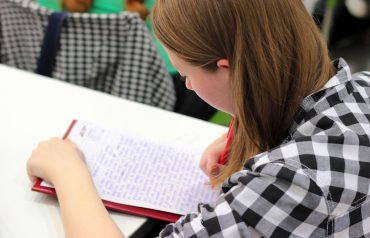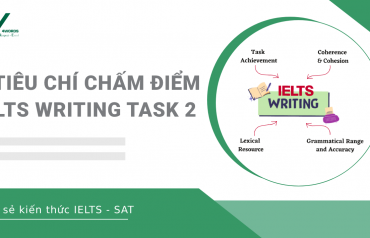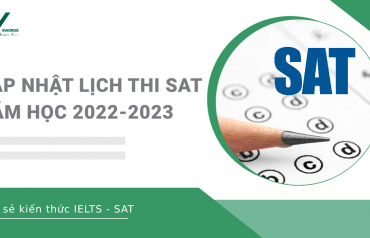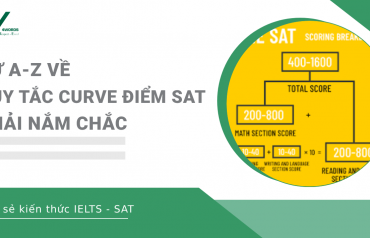Dạng câu hỏi Matching trong IELTS Reading và cách làm (tiếp)
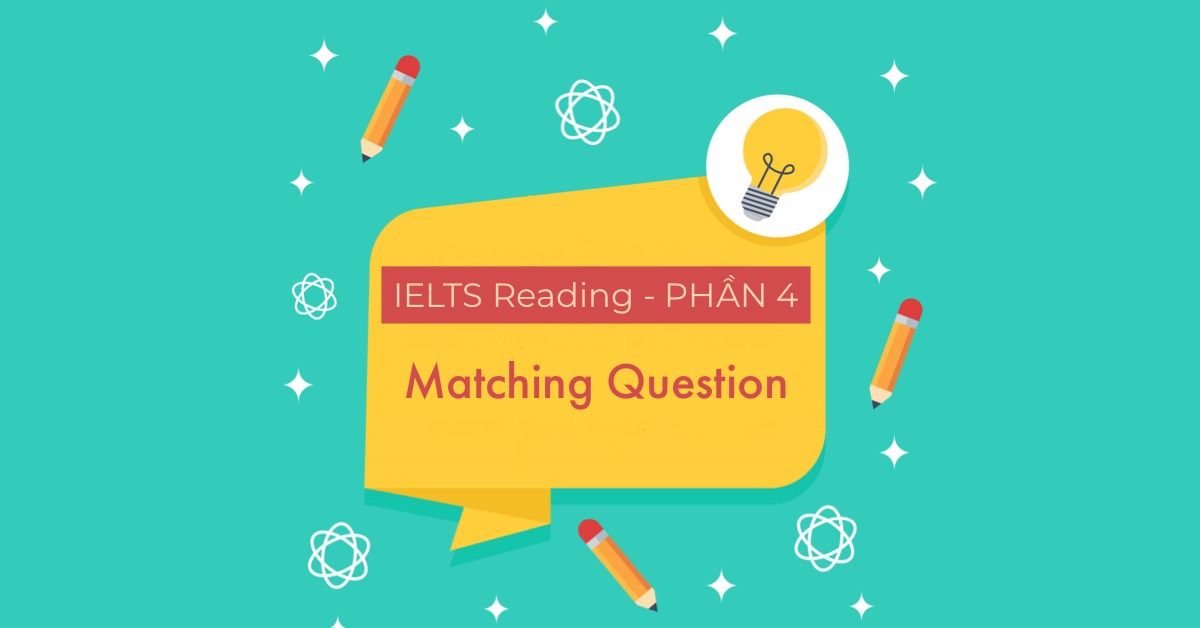
4.3. Matching sentence endings
Các câu hỏi là dạng thức một mệnh đề chưa hoàn chỉnh. Chúng yêu cầu hoàn thành bằng cách lựa chọn ghép với mệnh đề phù hợp từ danh sách các đáp án (A,B,C,D…). Các đáp án này cũng dưới dạng các mệnh đề chưa hoàn chỉnh. Với dạng này, chúng ta chú ý đến các danh từ riêng đã đưa ra trong câu hỏi. Từ đó, vận dụng chiến thuật quét thông tin (scanning) để tìm ra đáp án nhanh-chính xác nhất.
Hãy cùng 4WORDS tìm hiểu 3 bước cơ bản giải quyết loại câu hỏi Matching sentence endings này nhé.
Bước 1: Định vị thông tin
Đầu tiên, chúng ta luôn đọc câu hỏi trước và xác định từ khoá. Ghi nhớ từ khóa (keywords) là các từ ngữ không thay đổi (con số, tên riêng, thuật ngữ…). Hoặc từ đồng nghĩa với danh từ, động từ, tính từ… trong câu. Với câu hỏi ghép mệnh đề thành câu hoàn chỉnh, cần chú ý tới các từ nối (conjunctions).Việc này giúp xác định đúng nội dung thông tin cần tìm.
Bước 2: Xác định thông tin trong bài chứa từ khóa
Bước 3: Chọn đáp án và dùng phép loại trừ nếu cần thiết
Chú ý: Mỗi câu hỏi chỉ ứng với một đáp án. Khi tìm được đáp án cho câu hỏi nào, chúng ta nên gạch bỏ các đáp án đã chọn. Việc này giúp giải quyết các câu còn lại dễ dàng hơn.
Ví dụ:
In Aesop’s fable ‘The crow and the pitcher’ a thirsty crow uses stones to raise the level of water in a pitcher to quench its thirst. A new study published online today (06 August) in the journal Current Biology demonstrates that rooks, birds belonging to the corvid (or crow) family, are able to solve complex problems using tools and can easily master the same technique demonstrated in Aesop’s fable.
Christopher Bird of the University of Cambridge, lead author of the paper, highlighted the importance of the findings, stating: “Corvids are remarkably intelligent, and in many ways rival the great apes in their physical intelligence and ability to solve problems. The only other animal known to complete a similar task is the orang-utan. “This is remarkable considering their brain is so different to the great apes’. Although it has been speculated in folklore, empirical tests are needed to examine the extent of their intelligence and how they solve problems.”
In the first part of the study, at which point the researchers varied the height of the water, the four rooks which were the subject of the research used stones to raise the water level to reach a worm floating on top. The clever birds proved very adept and were highly successful regardless of the starting level of the water and the number of the stones needed. Two of the birds were successful on their first try to raise the height of the water to a level at which the worm floating on top could be reached whilst the other two birds needed a second try.
The birds were also highly accurate in their ability, adding the exact number of stones needed to raise the water level to the necessary height. Additionally, rather than attempting to reach the worm after each stone was dropped, they apparently estimated the number needed from the outset and waited until the appropriate water level was reached before dipping their beaks into the tube.
In the second experiment the rooks were presented with stones which varied in size. The rooks selected larger stones over smaller ones (although not straight away). The scientists speculate that the birds learnt rapidly that the larger stones displaced more water and they were therefore able to obtain the reward more quickly than using small stones.
In the third experiment, the rooks were observed to recognise that sawdust could not be manipulated in the same manner as water. Therefore when presented with the choice between a tube half-filled with either sawdust or water, rooks dropped the pebbles into the tube containing water and not the sawdust. Although the study demonstrates the flexible nature of tool use in rooks, they are not believed to use tools in the wild.
“Wild tool use appears to be dependent on motivation,” Bird said. “Rooks do not use tools in the wild because they do not need to, not because they can’t. They have access to other food that can be acquired without using tools.” As Bird noted, that fits nicely with Aesop’s maxim, demonstrated by the crow: “Necessity is the mother of invention.”
-Taken from The Official guide to IELTS-
Câu hỏi
- A new study has actually …
- The intelligence of birds has been suggested in stories, but…
- Half of the birds in the experiment were immediately successful; however, …
- The birds promptly realised the advantage of using big stones, and so…
- The research showed rooks can use tools with ease, though…
- The rooks worked out the properties of different materials and as a result, …
| A. …others needed several attempts.
B. …experts think that they don’t do this in their natural habitat. C. ….they achieved their goal sonner. D. …confirmed a fictional account. E. …helped us to understand a mysterious event. F. …only scientific studies can prove this. G. …they were able to protect themselves. H. …consistently rejected one particular type. |
Hướng dẫn trả lời câu hỏi:
Bước 1: Định vị thông tin
Đầu tiên, chúng ta luôn đọc câu hỏi trước và xác định từ khoá. Ghi nhớ từ khóa (keywords) là các từ ngữ không thay đổi (tên riêng, thuật ngữ…). Hoặc từ đồng nghĩa với danh từ, động từ, tính từ… trong câu.
Câu 1: A new study has actually ….
Bước 2: Xác định thông tin trong bài chứa từ khóa
In Aesop’s fable ‘The crow and the pitcher’ a thirsty crow uses stones to raise the level of water in a pitcher to quench its thirst. A new study published online today (06 August) in the journal Current Biology demonstrates that rooks, birds belonging to the corvid (or crow) family, are able to solve complex problems using tools and can easily master the same technique demonstrated in Aesop’s fable.
Bước 3: Chọn đáp án và dùng phép loại trừ nếu cần thiết
Câu hỏi “A new study has actually” có chủ ngữ (A new study), động từ (has actually). Tuy nhiên, động từ chính đằng sau bị thiếu.
Xét về ngữ pháp, lựa chọn A, B, C, G, F bị loại. Bởi các câu này đã là một mệnh đề độc lập hoàn chỉnh. Vì vậy chỉ còn lại D, E, H bắt đầu với các động từ (phương pháp loại trừ).
Thông tin đã xác định: A new study… demonstrates that rooks, birds belonging to the corvid (or crow) family, are able to solve complex problems using tools and can easily master the same technique demonstrated in Aesop’s fable. (Nghiên cứu mới chỉ ra loài quạ có khả năng sử dụng dụng cụ để giải quyết vấn đề phức tạp… như trong câu chuyển ngụ ngôn của Aesop)
=> Vậy D “confirmed a fictional account” là đáp án chính xác.
2. Practice
In Aesop’s fable ‘The crow and the pitcher’ a thirsty crow uses stones to raise the level of water in a pitcher to quench its thirst. A new study published online today (06 August) in the journal Current Biology demonstrates that rooks, birds belonging to the corvid (or crow) family, are able to solve complex problems using tools and can easily master the same technique demonstrated in Aesop’s fable.
Christopher Bird of the University of Cambridge, lead author of the paper, highlighted the importance of the findings, stating: “Corvids are remarkably intelligent, and in many ways rival the great apes in their physical intelligence and ability to solve problems. The only other animal known to complete a similar task is the orang-utan. “This is remarkable considering their brain is so different to the great apes’. Although it has been speculated in folklore, empirical tests are needed to examine the extent of their intelligence and how they solve problems.”
In the first part of the study, at which point the researchers varied the height of the water, the four rooks which were the subject of the research used stones to raise the water level to reach a worm floating on top. The clever birds proved very adept and were highly successful regardless of the starting level of the water and the number of the stones needed. Two of the birds were successful on their first try to raise the height of the water to a level at which the worm floating on top could be reached whilst the other two birds needed a second try.
The birds were also highly accurate in their ability, adding the exact number of stones needed to raise the water level to the necessary height. Additionally, rather than attempting to reach the worm after each stone was dropped, they apparently estimated the number needed from the outset and waited until the appropriate water level was reached before dipping their beaks into the tube.
In the second experiment the rooks were presented with stones which varied in size. The rooks selected larger stones over smaller ones (although not straight away). The scientists speculate that the birds learnt rapidly that the larger stones displaced more water and they were therefore able to obtain the reward more quickly than using small stones.
In the third experiment, the rooks were observed to recognise that sawdust could not be manipulated in the same manner as water. Therefore when presented with the choice between a tube half-filled with either sawdust or water, rooks dropped the pebbles into the tube containing water and not the sawdust. Although the study demonstrates the flexible nature of tool use in rooks, they are not believed to use tools in the wild.
“Wild tool use appears to be dependent on motivation,” Bird said. “Rooks do not use tools in the wild because they do not need to, not because they can’t. They have access to other food that can be acquired without using tools.” As Bird noted, that fits nicely with Aesop’s maxim, demonstrated by the crow: “Necessity is the mother of invention.”
-Taken from The Official guide to IELTS-
Câu hỏi
1. The intelligence of birds has been suggested in stories, but…
2. Half of the birds in the experiment were immediately successful; however,…
3. The birds promptly realised the advantage of using big stones, and so…
4. The research showed rooks can use tools with ease, though…
5. The rooks worked out the properties of different materials and as a result,…
I. …others needed several attempts.
J. …experts think that they don’t do this in their natural habitat.K. …they achieved their goal sonner. L. …confirmed a fictional account. M. …helped us to understand a mysterious event. N. …only scientific studies can prove this. O. …they were able to protect themselves. P. …consistently rejected one particular type. |
Đáp án
1. The intelligence of birds has been suggested in stories, but…
Đoạn văn “Corvids are remarkably intelligent, and in many ways rival the great apes in their physical intelligence and ability to solve problems. The only other animal known to complete a similar task is the orang-utan. “This is remarkable considering their brain is so different to the great apes’. Although it has been speculated in folklore, empirical tests are needed to examine the extent of their intelligence and how they solve problems.
Câu hỏi đưa ra cần có 2 mệnh đề nhượng bộ vì có liên từ nối ‘but’. Đáp án sẽ có ở những đoạn bắt đầu bằng các cụm từ nhượng bộ. Ví dụ như “although, however, whereas, nevertheless, in spite of….”. Dù sự thông minh họ quạ (corvids) được mô phỏng rất nhiều qua văn học dân gian, vẫn cần các bằng chứng thực nghiệm để kiểm tra mức độ thông minh của họ quạ và cách chúng giải quyết vấn đề.
=> Đáp án F “only scientific studies can prove this” (empirical tests = scientific studies, prove this = examine the extent of their intelligence and how they solve problems)
2. Half of the birds in the experiment were immediately successful; however,…
Câu 3 cũng tương tự như câu 2. Đây câu hỏi cần có 2 mệnh đề quan hệ nhượng bộ do nối bằng từ “however”.
In the first part of the study,……….. Two of the birds were successful on their first try to raise.the height.of the water to a level at which the worm.floating on top could be reached whilst the other two.birds needed a second try. (Một nửa thành công trong thí nghiệm trong khi một nửa còn lại cần phép thử lần hai)
=> Đáp án A “others needed several attempts” (a second try = several attempts).
3. The birds promptly realised the advantage of using big stones, and so…
Câu 4 đề cập đến mệnh đề nguyên nhân – kết quả do có từ “so”. Do đó, chúng ta có thể quét thông tin ở các đoạn văn gồm các từ khoá in đậm bên trên. Và các cụm từ chỉ kết quả “so, thus, hence, as a result, therefore…”.
The scientists speculate that the birds learnt rapidly that the.larger stones displaced more water and they were therefore.able to obtain the reward more quickly than using small stones. (vì nhận ra lợi ích của việc sử dụng những hòn đá lớn nên loài chim đã sử dụng chúng nhiều hơn)
=> Đáp án C “they achieved their goal sooner.” (obtain = achieve, reward = goal, quickly = sooner).
4. The research showed rooks can use tools with ease, though…
Câu 5 giống câu 2,3 vì đều là mệnh đề quan hệ nhượng bộ do có từ ‘though’.
Although the study demonstrates the flexible nature of tool use in rooks, they are not believed to use tools in the wild. (Dù các nghiên cứu chỉ ra rằng họ quạ có khả năng sử dụng.linh hoạt các công cụ đưa ra, chúng được tin rằng không sử dụng các công cụ này trong tự nhiên).
=> Đáp án B “experts think that they don’t do this in their natural habitat.” ( they are not believed = experts think that; in the wild = natural habitat).
5. The rooks worked out the properties of different materials and as a result,…
Câu 6 giống câu 4 chỉ về mệnh đề quan hệ nguyên nhân kết quả.
In the third experiment, the rooks were observed to recognise that.sawdust.could not be manipulated in the same manner as water. Therefore when presented with the choice between a tube half-filled with.either sawdust or water, rooks dropped the pebbles into the tube containing water and not the sawdust. (Do họ quạ nhận biết được tính chất của các nguyên liệu khác nhau, chúng.thả những viên sỏi vào bình chứa nước chứ không phải bình chứa mùn cưa)
Đáp án H “consistently rejected one particular type”.
Tin Liên quan
Tầm quan trọng của điểm GPA khi đi du học Mỹ
“GPA là gì? Điểm GPA đóng vai trò gì trong bộ hồ sơ du học Mỹ?”. GPA viết tắt cho Grade Point Average là điểm trung bình, là “giấy trắng mực đen” cho thành tích học tập của học...
20/03/2023Chạm vào giấc mơ Mỹ từ những chuyến xe mẹ chở đến trường
Tiếp xúc với nhiều thế hệ học sinh, 4WORDS luôn ấn tượng với hình ảnh phụ huynh đưa đón, chờ đợi con. 12 năm học bất kể nắng mưa. Có lẽ cũng là từng ấy năm cha mẹ chăm...
25/08/2020Cách giữ tập trung và bình tĩnh khi làm bài thi Nghe IELTS
Bài thi Nghe (Listening) là phần thi đầu tiên khi bạn tham gia thi IELTS. Vì vậy, việc giữ bình tĩnh để hoàn thành tốt bài thi Nghe IELTS là rất quan trọng. Điều này sẽ giúp cho bạn...
29/12/2021Hành trình từ số 0 tới nước Mỹ với học bổng toàn phần – Phần 2: “Không bây giờ thì sẽ rất tiếc nuối”
Nếu điểm số là tiêu chí cơ bản để cạnh tranh với các ứng viên thì bài luận và hoạt động ngoại khóa sẽ giúp bạn nổi bật. Mình đạt điểm số IELTS (7.5) và SAT (1460) tuyệt hơn...
19/06/2020College Board không còn tổ chức bài thi SAT Subject và SAT Essay
Trong bối cảnh dịch Covid-19, các trường đại học đang dần thích nghi với tình hình hiện nay bằng cách đưa ra những thay đổi về chính sách tuyển sinh. College Board cũng đang có những điều chỉnh về...
21/01/2021
